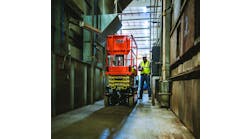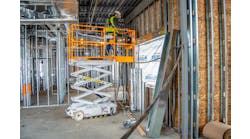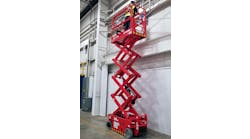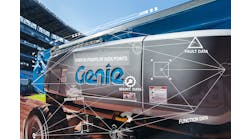Often referred to as “Mr. JLG,” Craig Paylor is the face of the aerial industry’s largest company and with good reason. Paylor joined JLG in 1978 as a district manager of sales and has held a variety of positions including regional manager, director of national accounts and director of international accounts. He became an officer of JLG in 1996, senior vice president of sales and market development in 1999, senior vp of sales marketing and customer assurance in 2001. Paylor was named president of JLG in May 2007 and is an executive vice president of Oshkosh Corp. During his 31-year tenure at JLG, Paylor has played a key role in supporting the company’s growth from a $40 million privately held company to a publicly traded global corporation with sales approaching $3 billion prior to acquisition. Paylor holds a masters degree from Harvard Business School. In this exclusive interview with RER, Paylor discusses JLG’s future plans, its award-winning LiftPod, the economy and lessons learned from the recession.
RER: How would you describe the state of JLG, considering how poor the market has been?
Paylor: Once we got past having to rightsize the company and we had to lay a lot of people off — which is extremely painful, especially for someone like myself that finally gets to this position and knows so many people. You realize that, after the uptick we had in the last cycle, it’s inherent that you’re too busy to catch all the waste. The people part is tough because nobody is wasted there. They are doing their job, they build machines, and all they are looking for is what machine to build next. When you run out of orders there’s not much you can do about it. What you can do is look at, “What do we do so that we’re better off when we come out of this thing?” That’s what we’ve been focusing on.
What else can you tell us about JLG’s future plans?
We’re continuing to look at international markets. We did not put our China factory on hold; we know we need to be there. We had a great year there and we continue to have good month-after-month results. We’re looking at low-cost sourcing to find ways to take costs out of our products and improve our delivery times. We’re looking for some alternatives to vendors that during the last upswing prevented us from going as far or as fast as we wanted to because they couldn’t deliver.
We’re continuing to invest in R&D to the degree that we can in certain machines that we know will be a large part of the recovery. That may mean taking costs out of what we have, it may be re-designing a machine altogether; that’s normal R&D.
The other big piece is making sure that we stay connected and invested and responsive in our aftermarket support. We don’t have as many people in the field as I’d like, but we’ve enhanced support through system integration and the general belief that when the machine goes out the door, that’s not the last thing we think about. That means we have to think about how to take care of the customer.
You have made some changes to your aftermarket structure, discontinuing the ServicePlus brand and moving everything under the JLG umbrella.
We still have two ServicePlus facilities. We’re basically tying those together with the independent service network that we’re growing because we know there are customers out there that can’t afford to send a machine for a long period of time into one of those yards. We still think those yards are integral. Our facilities in Riverside [Calif.] and Texas are busy, and we’re tying those into some of the other Oshkosh divisions where they have needs like we do.
JLG won quite a few awards for the LiftPod. How has it been accepted in the marketplace, particularly in rental?
When we came out of this recession the last time, when they were building all those “McMansions” as they call them, I would have loved to have had a Liftpod for everybody that needed to try to figure out how they were going to clean the windows and the lights on their 12-foot ceilings because that’s what this machine is perfect for. It’s more expensive than a ladder, but it’s safer than a ladder. We’ve had good success with it, it has been recognized for a lot of awards, and we’re doing OK with the sales. We’re just trying to understand the channel it’s going to take to get it to the customer that wants to use it.
How do you think it will go over with the rental market?
Will they accept it? Yes, there is no question that they will, but when? As soon as there’s enough consumers that would buy something and then realize they would like to have another one but they don’t want to buy it, that’s when it starts to become a great rental unit.
How has JLG’s Clear Sky telematics program been received by customers (especially rental companies) and what kind of improvements and new developments are on the horizon?
It depends on where you go, but to people who have big distances to travel, or have big fleets of equipment that they need better control of, yes, it’s valuable. Then you come back to the question of paying for it. Until you know what something does for you, you don’t know what it can save you. We’re going to put them on the Ultrabooms first. We want to be able to talk to them, which is what this system enables us to do, and find out what kind of problems they are having. When a customer calls and says a machine is down, we’ll be able to look up where that machine is and say “well, you might want to check this out or that out and see what’s going on,” and it gives us the ability to make a better new product leaving our facility.
It will be just like Sky Power was for us. Customers weren’t sure they wanted it until we made it standard and after they got it they won’t order anything without it. I think it will be a while before this kind of a system gets down into the smaller machines but for the big ones, they will quickly find out how much money they can save by knowing whether the machine is being used when it was called off rent.
When you look at what it costs a month to run Clear Sky, if you have one 2- or 3-day period of time where a customer calls off a machine and then you find out that Saturday, Sunday and Monday that machine was used nine hours a day and you go back and say “it might have been called off but you used it and here’s the information,” you’ve just paid for that system.
Are there any particular trends you see down the road in terms of product development?
It ties into what the recovery will look like. What the customers are going to want are the machines needed to work in the business that’s likely to come back first. And hopefully that’s going to be infrastructure stimulus work. We’re sitting on an infrastructure that’s actually falling apart. And that just means the equipment that is likely to be in high demand is probably going to be bigger booms for bridge inspections and that kind of work, bigger telehandlers that will be needed for working on those kinds of projects. I think that’s going to be what we’ll see first.
Any thoughts on the economy for the foreseeable future?
It’s kind of like if we decide to go on a diet and not drink for three weeks, you know how good that first beer tastes. I think that’s what this recovery will be like. I don’t see a change for this year. The snow months will start out a little slow. I’m hoping we’ll start to see some movement in the second half of 2010, or early spring through the summer and some of the fall. I don’t think it will be fantastic, I just think it will be better than where we’ve been. A lot of the big rental companies are going to have to buy new equipment, because the way they run their fleets, if they don’t buy some new equipment, their maintenance costs are going to blow through the roof. Are they going to be buying hundreds of millions of dollars of new equipment? Not a chance, but still it’s going to feel better than where we are today.
When the economy eventually improves, how will the industry have changed? What will manufacturers and rental companies/distributors have learned from this period?
I don’t think any reasonable manufacturer will judge their success by market share. I’m not going to run JLG on a “market share at all cost” basis; it’s going to be more reasonable from an operating income perspective. I’m not going to build waste into the system by chasing business that isn’t good business. We’re going to keep a rational development plan in place for products, a rational schedule in place, rational financing in place and chase customers that have a strong business plan. If that doesn’t equate to the market share that I had in the past, well, it doesn’t. Under my watch, I’m not dragging this company into where we just came from again, it’s not smart business.
I do think the smart rental companies are going to feel the same way. People have to start realizing you can’t run hard for five years and then decide you’re going to sell everything off at an auction.
Any new aftermarket services?
We’ve begun working with salesforce.com to keep live records and logs on our machines about problems that are happening in the market place or on products or jobsite conditions so that we know how to design into our new machines the ability to overcome those problems. Another one that we’ve been working on is Baseplan, a system we use in Australia inside the service vehicles themselves that go out and do a lot of remote work. When the mechanic gets back in the truck he can pull up where he’s been, the customer’s number, and write up what he did to the equipment and what parts he used. He hits a button that goes to corporate and the work gets billed to the customer. It allows corporate to know what he’s done on that particular job. They can look at what other annual updates need to be done, or if service is needed on other machines at that location. So we’re starting to use more technology that allows us to take the waste out of field support.
It’s an automated system right in the truck?
Yes.
Traditionally in the rental market, companies look to commercial construction as their primary customer base for aerial equipment. Is this changing during this recession? Should rental companies be concentrating more on government-funded projects or other areas?
Something good comes out of every bad storm. Customers all along the spectrum, big and small, will realize that running from big job to big job, or wherever the steel is at, and not paying attention to all the warehouses that you’re passing along the way, is really a waste of time. There are so many applications for the type of equipment that JLG makes that you can’t see driving down the highway. You’ve got to knock on some doors, do some cold calling. Find out how — in a 40-foot warehouse — they are changing their light bulbs. See where you might have an opportunity to sell a used piece of equipment.
When you start calling on those as a normal course of business, not only do you get a bigger customer base, but the guy knocking on the doors has to know something about the equipment. Unfortunately, during that last up cycle, there was a tendency for sales people to say “how much is your price, I can do a little bit better.” That serves no one, not even the end user, because he gets a cheaper price but that just translates into less service and support, older equipment or equipment that breaks down more often. When rental companies rent cheaper they can’t afford to do the work they should be doing. I do think they are knocking on some new doors now and it will change our business a little bit.
Another lesson that might be learned is there is no formal process that makes more sense in a good or a bad economy than eliminating waste. And one of the easiest ways to eliminate waste is to make sure that the equipment you are making today is valuable 10 years from now and make sure the equipment you buy today can still work 10 years from now. I was asked ‘what’s the cheapest steel that you can buy right now?’ and I said ‘the cheapest steel that you can find anywhere is sitting in your yard. I can tell you that steel is fine, it just needs to have some work done to it.’
Do you expect to go to ARA in 2010.
We didn’t go to ARA last year. I just couldn’t afford to go even though I would have liked to support ARA. We’ll be going to ARA in 2010.
How has being part of Oshkosh helped JLG during the recession?
One thing that’s helping us is the military business. We got a request in for over 5,000 machines, we’re building all the capsules to those, we ship half of the capsules to Oshkosh, and by December we’ll be up to 500 full machines made in McConnellsburg, and 500 being made by Oshkosh under its military division. If there was ever a time to really partner with your sister companies, we’re doing that at JLG. The military business has allowed us to bring back 500 people now, and we’ll probably bring back a total of about 650 people back.






